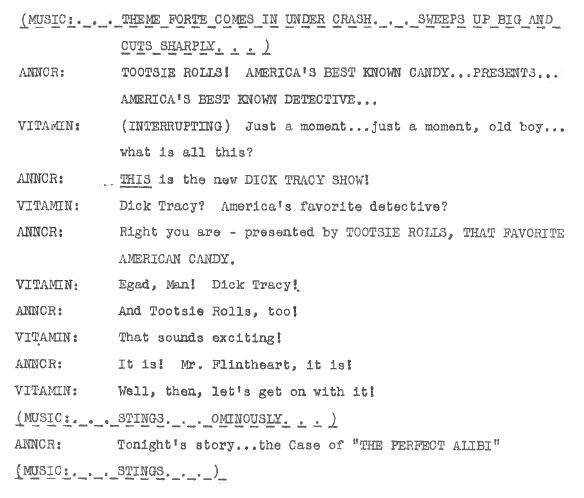This Week's Script Cavalcade: Dick Tracy on the Radio
He wears a bright yellow fedora and trench coat, has razor-sharp intuition and, working with a merry band of sidekicks, employs gadgets (including his famous two-way wristwatch radio) to track down wrongdoers and miscreants in the wake of violent crimes. He’s Dick Tracy, of course, and since his creation by Chester Gould and subsequent debut on the newspaper pages of the Detroit Mirror in 1931, he’s been the subject of all manner of serialized storytelling including films, live-action and animated TV series, radio shows and, first and foremost, comic strips. He’s one of America’s most recognizable and longest serving private eyes.

With all his recurrent sleuthing, we might contend that Tracy is a kind of grandfather to the modern-day, long-running detective or cop procedural. It’s this contention I’d specifically like to give pause to this week. The WGF Library recently processed a small bounty of radio show scripts from the mid-1940s. Many of these scripts, including The Dick Tracy Show, were written by Sidney Slon, who also famously served as head writer for the gritty and seminal pulp radio series, The Shadow.
Listeners could hear Dick Tracy’s adventures on the radio starting in 1934. The gumshoe’s grizzled voice continued to emanate over airwaves through the 1950s with the show switching networks, sponsors and lengths throughout its audible existence. The scripts in the WGF Library are specifically from 1945 and 1946 when the show aired on ABC in 30-minute segments and was proudly sponsored by Tootsie Roll.

In our world of over-saturation with all kinds of media vying desperately for our attention, it can be an informative relief to step back in time and examine a very direct, uncluttered mode of storytelling like radio. Library patrons with the ambition to create distinct, enduring characters whose exploits audiences continue to care about for decades, will find fundamental writing lessons exposed in the pages of these serialized radio capers.
On a warm Wednesday last week, I decided to peruse one of these scripts and found several things worth sharing, which hopefully will spur your imagination when you sit down to create your own nail-biting drama, whatever the form may be.

Just like today’s most compelling cop, detective, medical and other procedural shows, each Dick Tracy episode starts with a BANG! – usually literally.
It’s a bang we’d like to see resolved by the end of the episode – and it’s usually carried out by an obscenely un-likeable criminal or thug. It’s characters like Dick Tracy who provide us a kind of wish-fulfillment – that when bad things happen, we can figure out not only whodunit and how it happened, but also bring the morally in-the-wrong party to satisfying justice. In fact, the more unjust the situation at the top of the episode and the meaner the villain, the more truly gratifying it is to see the hero step up and fix things.
Dick Tracy is a unique kind of detective hero. He’s somewhat of a mug himself, which is why (tactically) he’s able to get inside the heads of the criminals he’s tracking and take them down. He might have the Al Capone look, but his heart and sense of making things right make him different and endlessly fascinating.

However, a radio hero can only be contradictory and compelling insofar as he has other characters to talk to. A common practice in the radio serial is to give the main character a sidekick or someone to explain things to along the way, so that the listening audience not only has a sense of the story, but also of the feelings of the protagonist. A necessity in radio is to make the characters speak and sound differently enough so that the audience can easily distinguish which character is talking. This is a tenet worthy of consideration even if you are writing for a visual medium. The person reading your script won’t have the visual cues to tell your characters apart, so it’s helpful to give even the smallest of characters a unique voice and cadence.
See the following examples featuring Tracy’s accomplice and a woman selling newspapers from The Case of the Nightclub Singer (1945)…


Finally, Alfred Hitchcock used to famously explain that a scene between two people talking at a table will become infinitely more suspenseful if the camera pans down and we see a ticking bomb underneath the table. What do you do if you’re writing for radio and you want to generate the same amount of suspense, but you have no camera to show the bomb? In radio, verbal threats and contracts become integral to raising stakes. The hero and the villain make declarative statements, such as “If you don’t bring the money to this place, by this time, this person will be hurt,” etc., setting up anticipation of a horrible event or showdown in the audience’s mind. The characters then must continually verbally remind each other how time is running out.

There’s a smattering of Dick Tracy Show radio scripts sitting behind the main library desk, see? And if you don’t get here before we close today to read and learn from them, your script will suffer… gradually and painfully.
Well, maybe not, but you should still browse our catalog, stop by and read newly processed scripts including:
- Every episode from every season of Girls.
- Screenplays from The Nutty Professor (1996) and Anchorman (2004).
- A few episodes of Freaks and Geeks.
